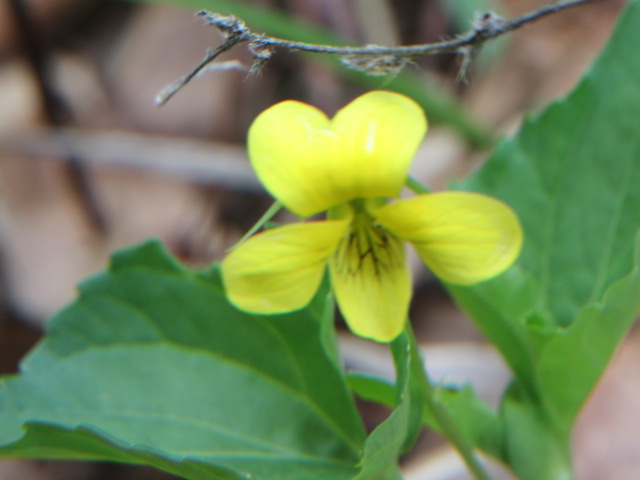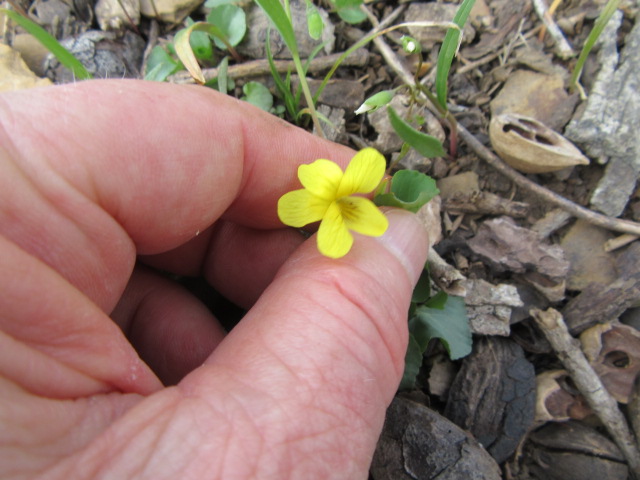
Viola pubescens (Downy Yellow Violet) on 4-18-20, #689-13.
NOTE: The Viola represented on this page is POSSIBLY now Viola eriocarpa (Smooth Yellow Violet) due to a taxon split. I will check plants to check for basal leaves, etc.
Downy Yellow Violet
Viola pubescens
vy-OH-la pew-BES-senz
Synonyms of Viola pubescens (8) (Updated on 12-30-23 from Plants of the World Online): Crocion pubescens (Aiton) Nieuwl., Viola pensylvanica Michx., Viola pubescens var. eriocarpon Nutt., Viola pubescens var. glabriuscula A.Gray, Viola pubescens f. peckii (House) Lévesque & Dans., Viola pubescens var. peckii House, Viola pubescens var. typica Grover, Viola uniflora var. pubescens (Aiton) Regel
Viola pubescens Aiton is the accepted scientific name for the Downy Yellow Violet. It was named and described as such by William Aiton in Hortus Kewensis in 1789.
The genus, Viola L., was named and described as such by Carl von Linnaeus in the second volume of the first edition of Species Plantarum in 1753.
As of 12-30-23 when this page was last updated, Plants of the World Online lists 681 species in the Viola genus. The genus is a member of the plant family Violaceae with a total of 24 genera. Those numbers could change periodically as updates are made on POWO.

Distribution map of Viola pubescens from Plants of the World Online. Facilitated by the Royal Botanic Gardens, Kew. Published on the Internet; http://www.plantsoftheworldonline.org/. Retrieved on December 19, 2021.
The above distribution map for Viola pubescens is from Plants of the World Online. Areas in green are where the species is native. The map on the USDA Plants Database and other sites may be a little different. They likely show lower taxon that are synonyms on POWO.
The map on iNaturalist shows where members have made observations. Anyone can join and it is a great website to confirm and share your observations. The maps on iNaturalist are continually updated as members post new observations.
THERE ARE SEVERAL LINKS AT THE BOTTOM OF THE PAGE FOR FURTHER READING AND TO HELP WITH A BETTER POSITIVE ID.

Viola pubescens (Downy Yellow Violet) on 4-18-20, #689-14.
I found several nice-sized colonies of Viola pubescens in the woods along the creek behind my farm (across the fence) a few years ago but didn’t take photos until April 18 in 2020. I really like this species of Viola because it has yellow flowers instead of the normal shades you would expect from Violets. The other interesting thing is their fruit… They look like little balls of cotton. Further down the page, you will see photos of their fruit that I took in the secluded woods on a friend’s farm on May 3, also in 2020. Then in 2022, I found a small colony next to a fence in the back pasture. This was great so I won’t have to cross the fence and go on a neighbor’s property or even leave the farm.

Viola pubescens (Downy Yellow Violet) on 4-18-20, #689-15.
Viola pubescens is the neatest Violets I have encountered. Not only because it has yellow flowers, but also for its fuzzy fruit. When I am out wildflower hunting, the first thing I notice is the flowers. This species is easily spotted and recognized as something way different than the norm, especially for a violet.

Viola pubescens (Downy Yellow Violet) on 4-18-20, #689-16.
As with all violets, they can be found mainly in wooded areas in light to part shade (or part sun). I have yet to understand the difference between part shade and part sun. They prefer loamy soil with organic matter with consistent moisture they normally get in the spring and early summer. They get a little more sun in the spring when the leaves start growing on the trees, then more shade later when the leaves have fully developed.
They are hardly seen in yards, or even flower beds, because they prefer undisturbed areas.

Viola pubescens (Downy Yellow Violet) on 4-18-20, #689-17.
I usually only cross the fence onto the neighbors farm when I go morel mushroom hunting in the spring. I always run across several wildflowers to photograph as well. It was great to see several colonies of Viola pubescens. I had never seen any until I found them in this wooded area along a creek.

Viola pubescens (Downy Yellow Violet) on 4-23-20, #690-112.
Viola pubescens is a perennial wildflower whose “stems” grow from an underground rhizome. Different violet species are either caulescent (having stems) or acaulescent (lacking stems). This species is caulescent since it does produce a stem. One or more can grow from the same rhizome. The stems are short, maybe 1” or so, and are not that strong so they have a tendency to flop (ascending). They are mostly hairless (glabrous) or can have some hairs (pubescent) that grow in longitudinal lines on the stem ridges.

Viola pubescens (Downy Yellow Violet) on 5-3-20, #695-61.
Besides having interesting yellow flowers for a violet, they have neat fuzzy fruit. Apparently, according to information online, their fruit can also be glabrous (hairless) but I haven’t seen any like that.

Viola pubescens (Downy Yellow Violet) on 5-3-20, #695-62.
Viola pubescens produces both basal and cauline leaves. The basal leaves emerge from the rhizome and are around 3” long and 2 1/2” wide with 3” long petioles (leaf stems).

Viola pubescens (Downy Yellow Violet) on 5-3-20, #695-63.
Cauline leaves grow in an alternate fashion along the stems are are smaller in size with shorter petioles. The basal and cauline leaves are heart-shaped (cordate) and have blunt to pointed teeth along the margins. There are stipules that emerge at the base of the cauline leaves which is an interesting feature common to all the violets I have observed.

Viola pubescens (Downy Yellow Violet) on 5-3-20, #695-64.
The above photo is a closer look at the fuzzy fruit…

Viola pubescens (Downy Yellow Violet) on 5-3-20, #695-65.
Leaves are either glabrous or may have a few very small hairs.

Viola pubescens (Downy Yellow Violet) on 5-3-20, #695-66.

Viola pubescens (Downy Yellow Violet) on 5-3-20, #695-67.

Viola pubescens (Downy Yellow Violet) on 5-3-20, #695-68.

Viola pubescens (Downy Yellow Violet) on 5-3-20, #695-69.
The above photo is of the stipules that grow from the base of the cauline leaves.

Viola pubescens (Downy Yellow Violet) on 5-1-22, #877-15.
While I was out wildflower hunting in the back of the farm on May 1 in 2022, I spotted a very small colony of Viola pubescens close to the fence. It was an exciting moment to find this species on the farm. I hadn’t seen it here before.

Viola pubescens (Downy Yellow Violet) on 5-1-22, #877-16).
The flowers emerge from the axils of cauline leaves on 2-3” long peduncles (flower stems). The peduncle nods downward at the top (apices) causing the flower to face outward. Flowers are around 3/4” wide and consist of five rounded petals and five light green sepals. The two lower lateral petals have white beards and may have a few dark veins beside the beards. The lower petal in the center has purple markings. The two upper petals have no hearts or markings. Later, inconspicuous cleistogamous (closed) flowers appear that are self pollinating due to the fact that very few pollinating insects visit their flowers.

Viola pubescens (Downy Yellow Violet) on 5-1-22, #877-17.
The above photo is a basal leaf. Notice the margins…

Viola pubescens (Downy Yellow Violet) on 5-1-22, #877-18.
The above photo shows a leaf petiole, stipules and a pundicle.

Viola pubescens (Downy Yellow Violet) on 5-1-22, #877-19.
And again,

Viola pubescens (Downy Yellow Violet) on 5-1-22, #877-20.
Well, I guess I got a little carried away and saved to many of the same thing.

Viola pubescens (Downy Yellow Violet) on 5-1-22, #877-21.
Several species of bees, butterflies, and flies feed on the nectar and pollen of violets but are not reliable pollinators. Caterpillars of some butterflies and moths feed on their leaves. Seeds are consumed to some extent by various birds. Ants seem to collect the seeds helping them to spread.

Viola pubescens (Downy Yellow Violet) on 5-1-22, #877-22.
Hmmm…

Viola pubescens (Downy Yellow Violet) on 5-1-22, #877-23.
The above photo shows the curve at the apice of the peduncle.
Hopefully, I will find the Viola pubescens here on the farm in 2023. I upload my observations on iNaturalist which is very addicting. Give it a try!
I have enjoyed photographing and learning about the many wildflowers growing on the family farm and in other areas. The farm is in Windsor, Missouri in Pettis County (Henry County is across the street, and Benton and Johnson aren’t far away). I have grown over 500 different plants and identified over 250 species of wildflowers (most have pages listed on the right side of the page). I am not an expert, botanist, or horticulturalist. I just like growing, photographing, and writing about my experience. I rely on several websites for ID and a few horticulturalists I contact if I cannot figure them out. Wildflowers can be somewhat variable from location to location, so sometimes it gets a bit confusing. If you see I have made an error, please let me know so I can correct what I have written.
I hope you found this page useful and be sure to check the links below for more information. They were written by experts and provide much more information. Some sites may not be up-to-date but they are always a work in progress. If you can, I would appreciate it if you would click on the “Like” below and leave a comment. It helps us bloggers stay motivated. You can also send an email to me at thebelmontrooster@yahoo.com. I would enjoy hearing from you especially if you notice something is a bit whacky.
FOR FURTHER READING:
PLANTS OF THE WORLD ONLINE (GENUS/SPECIES)
INTERNATIONAL PLANT NAMES INDEX (GENUS/SPECIES)
TROPICOS (GENUS/SPECIES)
FLORA OF MISSOURI (GENUS/SPECIES)
FLORA OF NORTH AMERICA (GENUS/SPECIES)
WORLD FLORA ONLINE (GENUS/SPECIES)
WIKIPEDIA (GENUS/SPECIES)
USDA PLANTS DATABASE
DAVE’S GARDEN
MISSOURI PLANTS
MISSOURI BOTANICAL GARDEN
MISSOURI DEPARTMENT OF CONSERVATION
iNATURALIST
WILDFLOWER SEARCH
ILLINOIS WILDFLOWERS
MINNESOTA WILDFLOWERS
KANSAS WILDFLOWERS AND GRASSES
NORTH CAROLINA STATE UNIVERSITY
GO BOTANY
LADY BIRD JOHNSON WILDFLOWER CENTER
FLORA FINDER
FRIENDS OF THE WILDFLOWER GARDEN
MARYLAND BIODIVERSITY PROJECT
MID ATLANTIC NATURE
SASKATCHEWAN WILDFLOWERS
ONTARIO WILDFLOWERS
EDIBLE WILD FOOD
LAKE FOREST COLLEGE
NOTE: The data (figures, maps, accepted names, etc.) may not match on these websites. It depends on when and how they make updates and when their sources make updates. Some websites have hundreds and even many thousands of species to keep up with. Accepted scientific names change periodically and it can be hard to keep with as well. Some of the links may use a name that is a synonym on other sites. In my opinion, Plants of the World Online by Kew is one of the most reliable and up-to-date plant databases and they make updates regularly. I make updates “at least” once a year and when I write new pages or add new photos but I do get behind. We are all a work in progress. 🙂

Viola pubescens (Downy Yellow Violet) on 3-31-24, #981-19.

Viola pubescens (Downy Yellow Violet) on 3-31-24, #981-20.